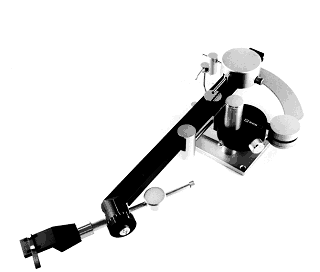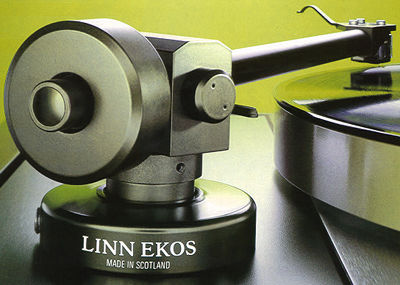The DV505 was released by Dynavector, a modest Japanese technical firm, and it shook the hi-fi world. Instead of the normal sales pitch, the company revealed the results of its considerable engineering research into tonearm shape and resonance characteristics. The world took notice quickly, and the DV505 went on to win the Design and Engineering Award at C.E.S. Chicago in 1977, and then again five years later!
When you look at the DV505, you can’t help but think it’s a piece of bizarre genius. The arm’s appearance is remarkable even today, so it’s impossible to say what people thought of it in the mid-1970s. It was huge, with a total length of 335mm and a weight of 1.25kg. Its size, in fact, prevent it from functioning correctly on most suspended subchassis decks. Even Michell’s colossal Orbe is content with weapons under a kilo, so it’s difficult to imagine what the ‘505 might do to weaker decks. When Dynavector wrote its baby, it had enormous unsprung direct drives like Technics’ SP10 in mind.
Despite its seeming intricacy, it is surprisingly simple to install, requiring only four screws to secure the baseplate. VTA is easily adjustable with two knobs, one for sliding the entire arm assembly up and down and the other for locking it in place. You can do this while playing a record on an unsuspended deck. The tracking weight adjustment is dynamic, which means you use a counterweight to level the (sub)arm and modify it with a spring dial, similar to the SME V. The cartridge weight range is a huge 23g, and there’s no finger lift, just like any true high-end design!
The separation of horizontal and vertical moving masses was the purpose of the DV505’s ‘bi-axis inertia separation’ technology. The arm was made up of two sub-arms that operated in separate lateral and vertical planes. The DV505 featured very high inertia for lateral action and very low inertia for vertical operation, whereas traditional gimbal designs have one arm that moves in both lateral and vertical directions (making the inertia in both planes equal).
It was all about lowering resonant frequencies. The vertical and horizontal pivots of traditional tonearms are close together, causing two resonance sources to oscillate at the same frequency, making the resonance louder and more difficult to dampen. The DV505’s two resonance peaks were smaller and hence could be damped more accurately by separating one pivot from the other.
Dynavector achieved this by employing a complex double damping system that included both electro-magnetic and inertia-controlled dampers. The former used eddy currents created by a conductor moving in a magnetic field to reduce resonances, and it was quite effective. The main arm’s second inertia-controlled dynamic damper comprised of a pair of finely matched springs and weights that oscillated solely in the horizontal plane when the arm’s major resonance mode occurred.
The combination of very high mass and strong damping in the horizontal plane and very low equivalent mass in the vertical plane was obtained by placing the shorter, lightweight vertical arm at the top of the horizontal arm. This resulted in greater information retrieval and groove tracing on warped records, according to Dynavector, a combination that was nearly impossible to achieve concurrently with conventional arms.
It sounded fantastic. It was undoubtedly the greatest sounding arm around at the time of its inception, if it was correctly coupled and set-up. Despite being extremely clear, smooth, and open, it was musically and dynamically stunning, with rock-solid recording. It could also be tweaked to get the most out of nearly any cartridge, which it typically did. It lacks the punch of the Linn Ekos and the detail of the SME V by today’s standards, but it can certainly teach a solid mid-price arm like the Ittok LVIII a thing or two.
Many years ago, the DV505 was phased out and replaced by the DV507. It’s a smaller, more rational refinement of the concept and an even better performer, despite its identical appearance. Dynavector, like a Japanese SME, is known for its excellent aftercare and service facilities. The arm isn’t as prevalent in the United Kingdom these days, but there are many for sale in Germany for roughly £800, depending on condition. This is the tonearm for you if you’re looking for something truly unique.







